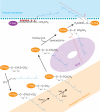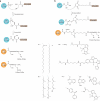Therapeutic intervention based on protein prenylation and associated modifications
- PMID: 16983387
- PMCID: PMC2892741
- DOI: 10.1038/nchembio818
Therapeutic intervention based on protein prenylation and associated modifications
Abstract
In eukaryotic cells, a specific set of proteins are modified by C-terminal attachment of 15-carbon farnesyl groups or 20-carbon geranylgeranyl groups that function both as anchors for fixing proteins to membranes and as molecular handles for facilitating binding of these lipidated proteins to other proteins. Additional modification of these prenylated proteins includes C-terminal proteolysis and methylation, and attachment of a 16-carbon palmitoyl group; these modifications augment membrane anchoring and alter the dynamics of movement of proteins between different cellular membrane compartments. The enzymes in the protein prenylation pathway have been isolated and characterized. Blocking protein prenylation is proving to be therapeutically useful for the treatment of certain cancers, infection by protozoan parasites and the rare genetic disease Hutchinson-Gilford progeria syndrome.
Figures






Similar articles
-
Targeting protein prenylation in progeria.Sci Transl Med. 2013 Feb 6;5(171):171ps3. doi: 10.1126/scitranslmed.3005229. Sci Transl Med. 2013. PMID: 23390246 Free PMC article. Review.
-
Inhibiting farnesylation reverses the nuclear morphology defect in a HeLa cell model for Hutchinson-Gilford progeria syndrome.Proc Natl Acad Sci U S A. 2005 Oct 4;102(40):14416-21. doi: 10.1073/pnas.0503712102. Epub 2005 Sep 26. Proc Natl Acad Sci U S A. 2005. PMID: 16186497 Free PMC article.
-
Inhibiting farnesylation of progerin prevents the characteristic nuclear blebbing of Hutchinson-Gilford progeria syndrome.Proc Natl Acad Sci U S A. 2005 Sep 6;102(36):12879-84. doi: 10.1073/pnas.0506001102. Epub 2005 Aug 29. Proc Natl Acad Sci U S A. 2005. PMID: 16129833 Free PMC article.
-
N6-isopentenyladenosine improves nuclear shape in fibroblasts from humans with progeroid syndromes by inhibiting the farnesylation of prelamin A.FEBS J. 2013 Dec;280(23):6223-32. doi: 10.1111/febs.12544. Epub 2013 Nov 18. FEBS J. 2013. PMID: 24112551
-
Protein prenylation: enzymes, therapeutics, and biotechnology applications.ACS Chem Biol. 2015 Jan 16;10(1):51-62. doi: 10.1021/cb500791f. Epub 2014 Dec 8. ACS Chem Biol. 2015. PMID: 25402849 Free PMC article. Review.
Cited by
-
The prenyl-binding protein PrBP/δ: a chaperone participating in intracellular trafficking.Vision Res. 2012 Dec 15;75:19-25. doi: 10.1016/j.visres.2012.08.013. Epub 2012 Aug 29. Vision Res. 2012. PMID: 22960045 Free PMC article. Review.
-
Small molecule inhibition of the KRAS-PDEδ interaction impairs oncogenic KRAS signalling.Nature. 2013 May 30;497(7451):638-42. doi: 10.1038/nature12205. Epub 2013 May 22. Nature. 2013. PMID: 23698361
-
Photoswitchable Isoprenoid Lipids Enable Optical Control of Peptide Lipidation.ACS Chem Biol. 2022 Oct 21;17(10):2945-2953. doi: 10.1021/acschembio.2c00645. Epub 2022 Oct 4. ACS Chem Biol. 2022. PMID: 36194691 Free PMC article.
-
Emerging Role of Migration and Invasion Enhancer 1 (MIEN1) in Cancer Progression and Metastasis.Front Oncol. 2019 Sep 4;9:868. doi: 10.3389/fonc.2019.00868. eCollection 2019. Front Oncol. 2019. PMID: 31552186 Free PMC article. Review.
-
Blockade of protein geranylgeranylation inhibits Cdk2-dependent p27Kip1 phosphorylation on Thr187 and accumulates p27Kip1 in the nucleus: implications for breast cancer therapy.Mol Cell Biol. 2009 Apr;29(8):2254-63. doi: 10.1128/MCB.01029-08. Epub 2009 Feb 9. Mol Cell Biol. 2009. PMID: 19204084 Free PMC article.
References
-
- Sakagami Y, et al. Isolation of a novel sex hormone tremerogen A-10, controlling conjugation tube formation in Tremella mesenterica fries. Agric. Biol. Chem. 1978;42:1093–1094.
-
- Tsuchiya E, Fukui S, Kamiya Y, Sakagami Y, Fujino M. Requirements of chemical structure for hormonal activity of lipo-peptidyl factors inducing sexual differentiation in vegetative cells of heterobasidiomycetous yeasts. Biochem. Biophys. Res. Commun. 1978;85:459–463. - PubMed
-
- Anderegg RJ, Betz R, Carr SA, Crabb JW, Duntze W. Structure of Saccharomyces cerevisiae mating hormone a-factor. Identification of S-farnesyl cysteine as a structural component. J. Biol. Chem. 1988;263:18236–18240. - PubMed
-
- Glomset JA, Gelb MH, Farnsworth CC. Prenyl proteins in eukaryotic cells: a new type of membrane anchor. Trends Biochem. Sci. 1990;15:139–142. - PubMed
Publication types
MeSH terms
Substances
Grants and funding
LinkOut - more resources
Full Text Sources
Other Literature Sources

